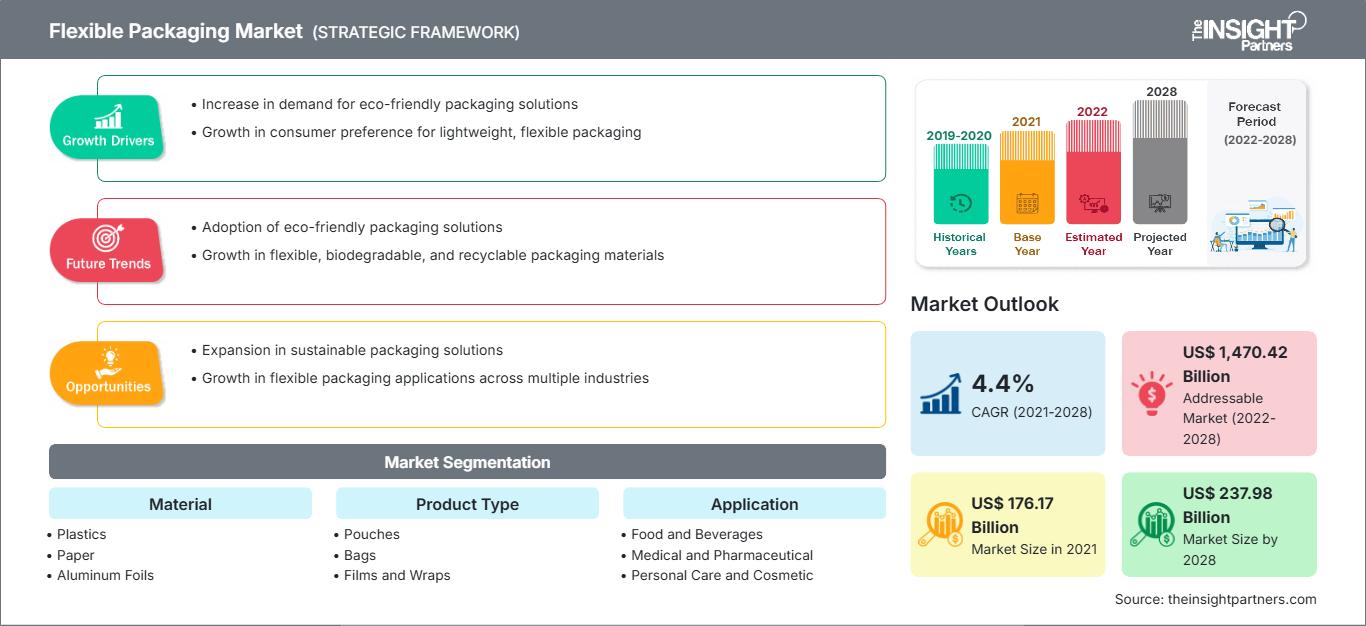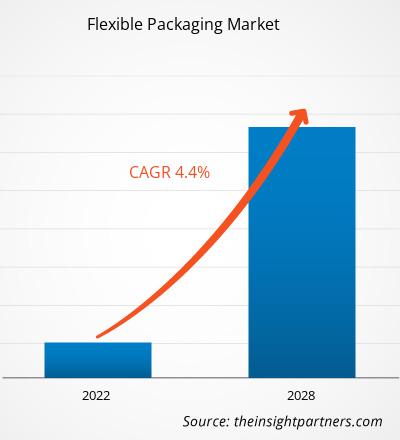연성 포장 시장은 2021년 1,761억 7,361만 달러에서 2028년 2,379억 7,567만 달러로 성장할 것으로 예상되며, 2021년부터 2028년까지 연평균 성장률 4.4%로 성장할 것으로 예상됩니다.
연성 포장에는 라이너, 파우치, 씰, 샘플 패킷, 백 등이 포함됩니다. 필름, 플라스틱, 종이, 호일 등으로 제작될 수 있으며, 다양한 식음료, 소비재, 음악 CD, 의약품, 컴퓨터 소프트웨어 패키지, 건강기능식품 등에 사용됩니다. 연성 포장은 내구성이 뛰어나 제조업체가 시선을 사로잡는 고품질 맞춤형 디자인을 인쇄할 수 있도록 하여 소매점에서 제품 가시성을 높입니다.
2020년 아시아 태평양 지역은 세계 연성 포장 시장에서 가장 큰 매출 점유율을 기록했습니다. 아시아태평양 경제협력체(APEC)에 따르면 호주는 APAC 지역의 선진국 중 하나입니다. 식음료 부문은 호주 최대 제조업으로, 호주 전체 제조업 매출의 32%를 차지합니다. 호주식품식료품협회(Australian Food and Grocery Council)의 2019년 산업 현황 보고서에 따르면, 식음료, 식료품, 신선 농산물 부문의 시장 규모는 미화 853억 2천만 달러에 달합니다. 이 산업은 다양한 규모의 15,000개 기업으로 구성되어 있으며, 27만 3천 명 이상의 직원을 고용하고 있습니다. 성장하는 식음료 산업은 유연 포장 시장을 견인하고 있습니다.
이 보고서의 일부, 국가 수준 분석, Excel 데이터 팩을 포함하여 모든 보고서에 대한 사용자 정의를 무료로 받을 수 있을 뿐만 아니라 스타트업 및 대학을 위한 훌륭한 제안 및 할인을 이용할 수 있습니다
유연 포장 시장: 전략적 통찰력

-
이 보고서의 주요 주요 시장 동향을 확인하세요.이 무료 샘플에는 시장 동향부터 추정 및 예측에 이르기까지 데이터 분석이 포함됩니다.
COVID-19 팬데믹이 유연 포장 시장에 미치는 영향
제조 시설 폐쇄, 원자재 조달 어려움, 물류 제약은 유연 포장 시장에 부정적인 영향을 미쳤습니다. 그러나 COVID-19로 인해 온라인 식료품 배송이 급증했습니다. 또한, 소비자들이 식료품 저장실을 채우기 위해 서두르면서 포장 식품 및 음료 업계에서는 유제품을 포함한 상온 보관 식품 및 음료에 대한 수요가 급증하고 있습니다. 수백만 가구가 온라인으로 식료품을 구매하여 픽업하거나 집으로 배송받기 시작했으며, 많은 가구가 위기가 지나간 후에도 전자상거래 옵션을 계속 이용할 것입니다. 또한, 유통기한 연장을 위해 일반적으로 고차단성 고급 포장재를 사용하는 편의 식품과 같은 가공 식품에 대한 수요 증가는 유연 포장의 필요성을 더욱 부추길 것으로 예상됩니다.
시장 분석
가공 식품 소비 증가 및 음료
Anu Food Brazil 보고서에 따르면, 브라질 식품 소매 부문의 2019년 총 매출은 960억 달러였습니다. 브라질의 식음료 산업은 2019년에 6.7%, 2020년에는 12.8%의 성장률을 기록했습니다. 브라질의 냉동식품 시장은 호황을 누리고 있습니다. 브라질의 냉동식품 시장은 중산층의 확대, 구매력 향상, 그리고 정규직 근로자 수의 증가로 호황을 누리고 있습니다. 따라서 편의식품에 대한 소비자 선호도 증가가 유연 포장 시장을 견인하고 있습니다.
소재 산업 통찰력
소재를 기준으로 전 세계 유연 포장 시장은 플라스틱, 종이, 알루미늄 호일 등으로 세분화됩니다. 플라스틱 부문은 2020년 전 세계 유연 포장 시장에서 가장 큰 점유율을 차지했습니다. 유연 플라스틱 포장에는 다양한 제품 포장에 사용되는 다양한 유형의 플라스틱 소재가 포함됩니다. 포장에 사용되는 재료의 종류는 포장 대상 제품의 용도와 종류에 따라 달라집니다. 일반적으로 폴리에틸렌, 폴리프로필렌, 폴리스티렌, 폴리염화비닐과 같은 플라스틱 소재가 연성 플라스틱 포장에 사용됩니다. 연성 포장은 식품, 음료, 의약품 및 여러 소모품의 보관, 유통 및 포장에 가장 편리하고 경제적인 방법으로 여겨집니다.
글로벌 연성 포장 시장의 주요 기업으로는 Amcor plc, Huhtamaki, Mondi, Berry Global Inc., Sealed Air, Sonoco Products Company, Coveris, Constantia Flexibles, Flexpak services, Transcontinental Inc. 등이 있습니다. 이 시장에서 활동하는 기업들은 고객의 요구 사항을 충족하는 고품질의 혁신적인 제품 개발에 주력하고 있습니다.
연성 포장
유연 포장 시장 지역별 통찰력
The Insight Partners의 분석가들은 예측 기간 동안 유연 포장 시장에 영향을 미치는 지역별 동향과 요인들을 면밀히 분석했습니다. 이 섹션에서는 북미, 유럽, 아시아 태평양, 중동 및 아프리카, 그리고 중남미 지역의 유연 포장 시장 부문과 지역별 현황도 살펴봅니다.
유연 포장 시장 보고서 범위
| 보고서 속성 | 세부 |
|---|---|
| 시장 규모 2021 | US$ 176.17 Billion |
| 시장규모별 2028 | US$ 237.98 Billion |
| 글로벌 CAGR (2021 - 2028) | 4.4% |
| 이전 데이터 | 2019-2020 |
| 예측 기간 | 2022-2028 |
| 다루는 세그먼트 |
By 재료
|
| 포함된 지역 및 국가 |
북미
|
| 시장 선도 기업 및 주요 회사 프로필 |
|
유연 포장 시장 참여자 밀도: 비즈니스 역학에 미치는 영향 이해
연성 포장 시장은 소비자 선호도 변화, 기술 발전, 그리고 제품의 이점에 대한 인식 제고 등의 요인으로 인한 최종 사용자 수요 증가에 힘입어 빠르게 성장하고 있습니다. 수요가 증가함에 따라 기업들은 제품 라인업을 확장하고, 소비자 니즈를 충족하기 위한 혁신을 추진하며, 새로운 트렌드를 적극 활용하고 있으며, 이는 시장 성장을 더욱 가속화하고 있습니다.

- 을 얻으세요 유연 포장 시장 주요 주요 플레이어 개요
보고서 스포트라이트
- 유연 포장 산업의 진보적 추세는 플레이어가 효과적인 장기 전략을 개발하는 데 도움이 됩니다.
- 선진국과 개발도상국의 시장 참여자가 채택한 사업 성장 전략
- 2019년부터 2028년까지 유연 포장 시장에 대한 정량적 분석
- 유연 포장에 대한 글로벌 수요 추정
- 산업에서 운영되는 구매자와 공급업체의 효율성을 보여주기 위한 포터의 5가지 힘 분석
- 경쟁적인 시장 시나리오를 이해하기 위한 최근 개발
- 시장 추세 및 전망과 유연 포장 시장 성장을 주도하고 제한하는 요소
- 상업적 관심을 뒷받침하고 시장 성장을 이끄는 시장 전략을 강조하여 의사 결정 프로세스 지원
- 다양한 노드에서의 유연 포장 시장 규모
- 시장과 산업에 대한 자세한 개요 및 세분화 역학
- 성장 가능성이 유망한 다양한 지역의 유연 포장 시장 규모
- 과거 분석(2년), 기준 연도, CAGR을 포함한 예측(7년)
- PEST 및 SWOT 분석
- 시장 규모 가치/거래량 - 글로벌, 지역, 국가
- 산업 및 경쟁 환경
- Excel 데이터세트
최근 보고서
사용 후기
구매 이유
- 정보에 기반한 의사 결정
- 시장 역학 이해
- 경쟁 분석
- 고객 인사이트
- 시장 예측
- 위험 완화
- 전략 기획
- 투자 타당성 분석
- 신흥 시장 파악
- 마케팅 전략 강화
- 운영 효율성 향상
- 규제 동향에 발맞춰 대응






















 무료 샘플 받기 - 유연 포장 시장
무료 샘플 받기 - 유연 포장 시장